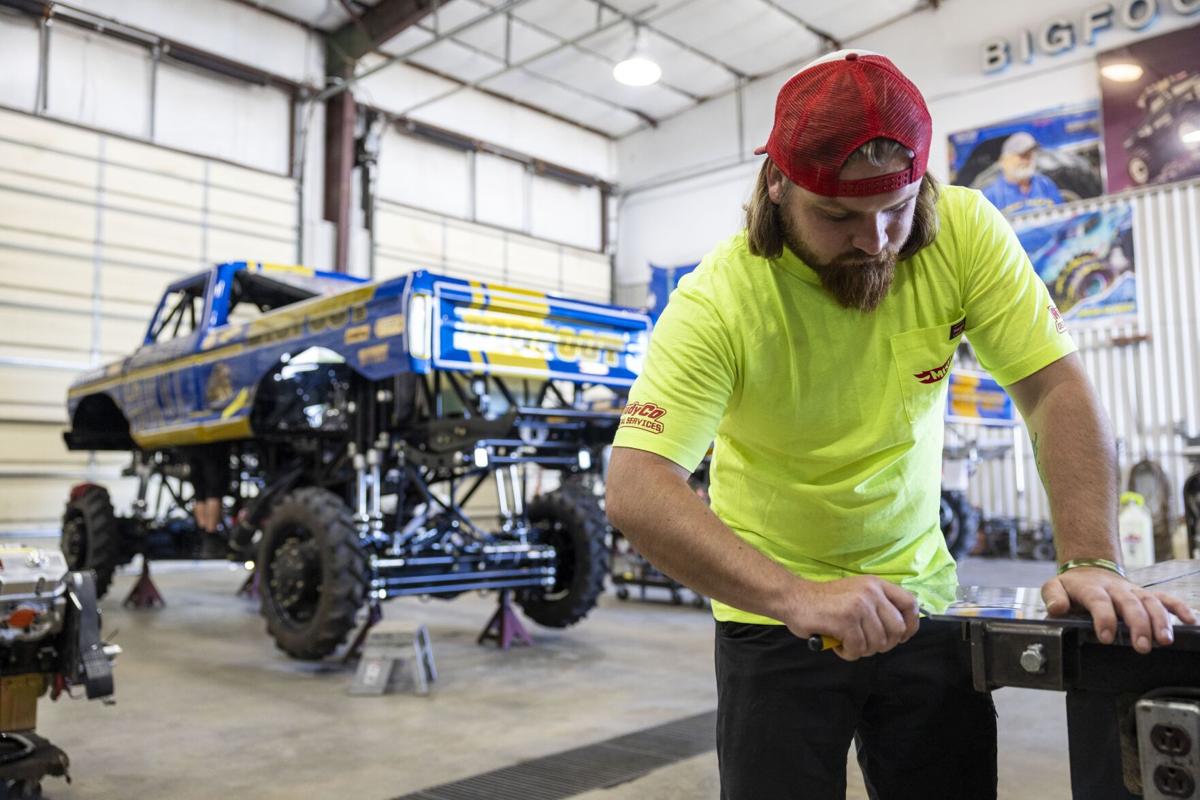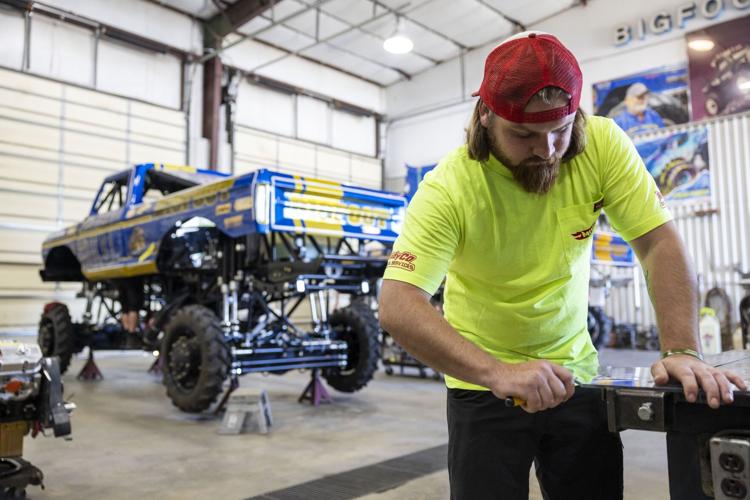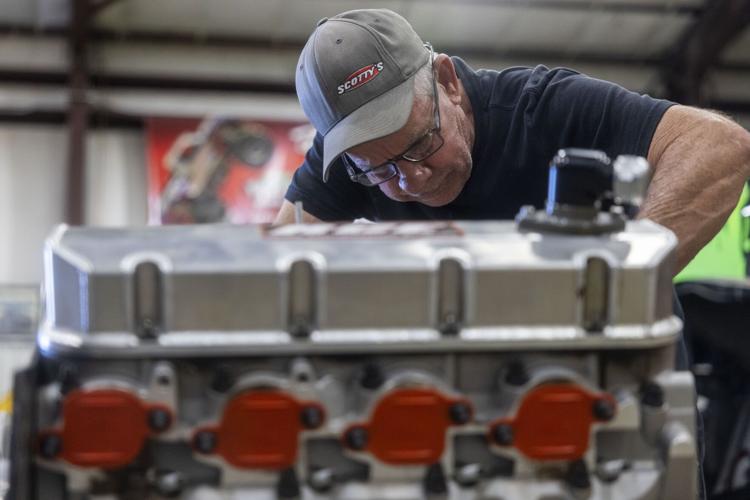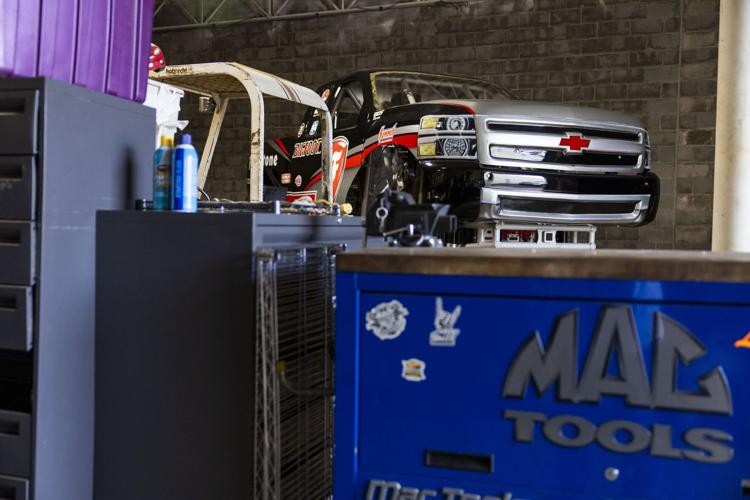PACIFIC — In the early years, those behind Bigfoot 4x4 — the locally based, pioneering monster truck company — thought that the destructive trucks atop giant farm-equipment tires could be a passing fad, “like a pet rock,” says CEO Ann Trent.
They needn’t have worried. Dozens of trucks, countless crushed cars and waves of ever-improving technology later, Bigfoot celebrated its 50th anniversary this month with visiting monster trucks and thousands of fans at its Pacific headquarters.
Bigfoot’s conventional trucks, which run on methanol, are as popular as ever — reflected by jam-packed, globe-spanning tour dates that have its fleet booked through 2028, plus an eruption of licensees’ sales of toys, video games and other merchandise that has quadrupled in just the last four years.

Dan Runte, vice president of Bigfoot 4X4 Inc., works on a Chevrolet engine that is being prepped as a spare for Bigfoot 24 at Bigfoot 4X4 Inc.’s shop in Pacific on Thursday, June 19, 2025.
The milestone has the makers of “The Original Monster Truck” considering what’s next for the flourishing industry they’ve helped to create. They — and some competitors — say electric versions of monster trucks will likely find roles alongside internal-combustion-engine trucks, mirroring broader trends as the automotive world.
People are also reading…
- Exclusive streaming of Cardinals-Cubs on July 4 will be bitter Apple for some: Media Views
- 2 killed in wrong-way crash in St. Louis were a ‘concert lover’ and a grandmother
- Police bust Jefferson County gas stations for alleged illegal gambling machines
- With financial storm clouds brewing, Kehoe takes ax to Missouri budget
“The way the world’s going right now, I think that’s what’s going to happen,” said Bob Trent, Bigfoot’s vice president and chief operating officer.
Indeed, outside of monster truck arenas, public roadways and dealerships are seeing more car models get electrified, including bigger vehicles like the Ford F-150 Lightning and Rivian trucks.
Electric trucks aren’t uncharted territory for Bigfoot, which already harnessed the technology in one unique chapter of its history. The team built an electric truck back in 2012 — Bigfoot No. 20 — using 36 car batteries stacked in different parts of the rig.
“The electric truck, I thought, was like the coolest thing ever, because nobody had ever considered doing something like that,” said Ann Trent.
‘You hear cars crushing’
The idea for the truck emerged from a conversation with Odyssey Battery, a Bigfoot sponsor, at the 2011 trade show for the Specialty Equipment Market Association, where specialized automotive equipment manufacturers showcase new innovations. The Bigfoot team put the truck together in time for it to make its public debut at the same show the following year.
In the world of monster trucks, Bigfoot No. 20 stands out for more than just its power source. The lack of a deafening engine creates a very different experience for drivers and fans.
“You hear the cars crushing,” said Dan Runte, a Bigfoot shop foreman who also spent decades as a record-setting driver.
“You hear tings and tongs that you’ll never hear in one of these,” he said, gesturing toward the conventional trucks in the garage.
That lack of a roaring engine can be both a positive and a negative in the eyes (or ears) of fans.
“Most people like the noise,” says Bob Trent. “That’s part of what they do.”
But some people, including kids with autism, prefer the silent trucks.
Bob Brown, a Bigfoot mechanic with extensive experience driving the electric truck, said it’s a “capable” truck. An added bonus, he says, comes from its evenly balanced weight because of the 36 car batteries, when the truck takes flight for airborne stunts.
“It lands perfect every time,” he said.

Bigfoot 20, the worlds first electric monster truck sits in storage at a facility near to Bigfoot 4X4 Inc.’s shop in Pacific on Thursday, June 19, 2025.
Bigfoot’s trailblazing electric truck has mainly been in storage since returning last year from a temporary exhibit at a car museum in Georgia. The truck will typically get used a few times per year, Bob Trent said, often on display at festivals or events ranging from the Country Music Association Awards to the Indianapolis 500.
It also made an appearance at Bigfoot’s recent 50th anniversary event with its wheels off, allowing fans to easily peek at its battery-laden inner workings.
The electric truck could hint at a growing slice of the fleet’s future, especially given the extent to which battery and electric vehicle technology has advanced and matured over the past decade.
And part of the push toward electrification could also come from afar, since Bigfoot caters to worldwide audiences and aims to keep up with global automotive trends.
For example, on a recent morning in its Pacific garage, workers were readying a truck to embark on a trip to Mexico and multiple stops in the Middle East. And some trucks essentially stay overseas, moving from one continent to another for international shows. In the late 1990s, the team says, Bigfoot No. 9 was confiscated in Brazil and hasn’t been returned.
The accelerating transition toward electric vehicles in Europe, in particular, could wield outsized influence even on monster trucks, Bob Trent said. For instance, the European Union has set a target for sales of new vehicles to be entirely electric by 2035.
“Europe is gonna be the fastest thing that makes it go electric, before the States do,” he said. Looking ahead, he guesses that Bigfoot will have another electric truck built “within the next five years.”
Beyond Bigfoot’s garage, others in the business are also exploring electric monster trucks and share the intrigue about them.
“We are looking into it,” said Tim Hall, president of Hall Brothers Racing, a monster truck team based in Champaign, Illinois. “I know there are gonna be more electric monster trucks. ... Someday I’d like to be able to compete with (Bigfoot’s) electric truck with one of our own.”
As long as a new technology is safe, Hall says monster trucks can offer an ultimate proving ground that can even help provide insights to manufacturers.

A Bigfoot truck leaps high in the air before crushing some cars in 2011.
“Monster trucks live in a violent world,” he said, speaking over the phone while on the road for a Monster Jam event in Georgia. “They are a very good way to test technology in one of the most extreme ways.”
And he says people within the industry are inclined to be curious about new frontiers like electrification — even if some are keeping that work secret, for now.
“Monster truck people, they tend to be inventive,” he said. “Certainly as technology evolves, I think all the top-level race teams will be ready to evolve with it.”
Meanwhile, other technologies or power sources could also be on the horizon, perhaps unsurprisingly in a world where fuel economy is measured in “gallons per mile,” said Ann Trent, with about 20 to 25 gallons of methanol used for a 20-minute Bigfoot performance.
For instance, Eric Steinberg, a Bigfoot driver, points to a hydrogen-powered truck that a Utah-based team called Throttle Monster has debuted, in addition to the curiosity about electric trucks.
“They’re kind of testing new ways, within the industry,” said Steinberg, discussing alternative-powered monster trucks. “Definitely down the road, I can see a lot more coming out.”
Whatever awaits, those around the Bigfoot garage recognize that the trucks will continue to evolve, even if in ways that can’t be clearly predicted.
“Everything’s fun in monster trucks,” said Steinberg.
Monster truck driver Kayla Blood says she loves inspiring girls by driving Sparkle Smash, which will be at Monster Jam at The Dome at America's Center Jan. 18 and 19, 2025. Video by Seeger Gray, sgray@post-dispatch.com
















